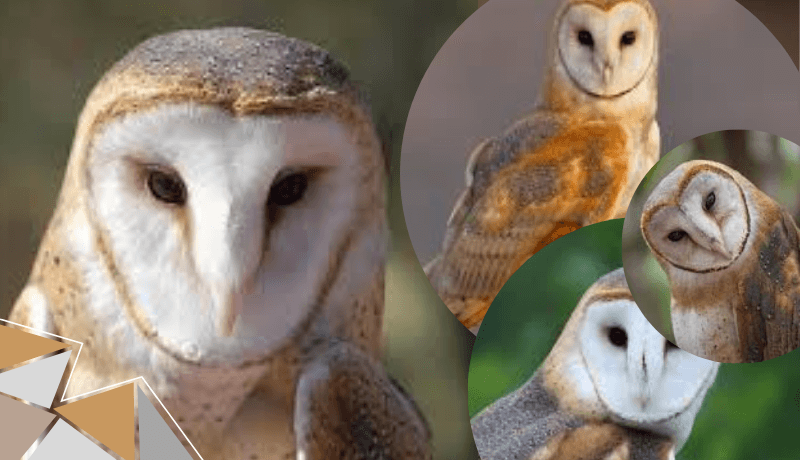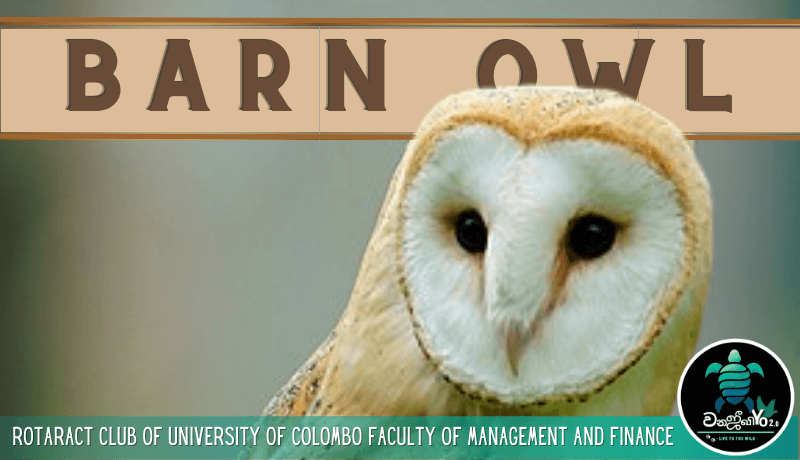Barn Owl is commonly identified as the most widespread Owl species. Concerning the taxonomy, there are between 28 and 35 recognized subspecies of Tyto alba. They also typically have a short lifespan of 21 months however specifically in the UK the typical lifespan is over 4 years.
Barn Owl was initially introduced to the Hawaiian Islands, Seychelles Islands, and St. Helena to control invasive rats. As a native species, it is widely distributed all around the world. However, it is listed as a Species of European Conservation Concern and as endangered in seven U.S. states.
Barn Owl is a medium-sized owl measuring between 29-44 cm and its body mass is highly variable between locations, with most ranging from 187-475 g. The wing chord of it measures around 80-95 cm. Female species are generally larger in all measurements except wing chord and tail length, and they are typically darker than males. They also lack the ear tufts that can be commonly seen among owls, have dark iris eyes, and have a prominent heart-shaped face.
Concerning the diet, it is highly variable and flexible and Tyto alba is not known to dramatically impact populations of threatened or endangered species, and they predominantly prey on partially nocturnal small rodents and even small numbers of lagomorphs, mustelids, social-roosting and open-roosting passerines, seabirds, bats, and insects.
Barn Owl usually begins their breeding season in March-July and typically lay 4-7 eggs.
When it comes to natural enemies, Great Horned Owls (Bubo virginianus) have been reported to predate upon Tyto alba in Iowa, USA, but there are few reports of such predation in the wild. Adult Tyto alba is taken occasionally by a variety of large raptor species and Tyto Alba nestlings are predated upon by snakes and stoats in North America.

බහුලවම පැතිරී ඇති බකමූණ විශේෂය ලෙස පොදුවේ හඳුනා ගැනේ. වර්ගීකරණය සම්බන්ධයෙන් ගත් කළ, පිළිගත් උප විශේෂ 28 ත් 35 අතර ප්රමාණයක් ඇත. ඔවුන්ට සාමාන්යයෙන් මාස 21 ක කෙටි ආයු කාලයක් ඇත, කෙසේ වෙතත් විශේෂයෙන් එක්සත් රාජධානියේ සිටින බකමූණන්ගේ සාමාන්ය ආයු කාලය අවුරුදු 4 ඉක්මවයි.
අටු වෙස්බස්සා මුලින් ම හඳුන්වා දෙනු ලැබුවේ හවායි දූපත්, සීෂෙල්ස් දූපත් සහ සෙන්ට් හෙලේනා යන ප්රදේශවල සිටින ආක්රමණශීලී මීයන් පාලනය කිරීමට යි. දේශීය විශේෂයක් ලෙස, ඔවුන් ලොව පුරා පුළුල් ලෙස පැතිරී ඇත. කෙසේ වෙතත්, ඔවුන්ව යුරෝපයේ සංරක්ෂණ කල යුතු විශේෂයක් ලෙස ලැයිස්තුගත කර ඇති අතර එක්සත් ජනපදයේ ප්රාන්ත හතක වඳවීමේ තර්ජනයට ලක්ව ඇත.
අටු වෙස්බස්සා යනු මධ්යම ප්රමාණයේ බකමූණෙකු වන අතර සෙන්ටිමීටර 29-44 අතර ප්රමාණයක දිගින් යුක්ත වේ. ශරීර ස්කන්ධය ඔවුන් ජීවත් වන ප්රදේශය අනුව බෙහෙවින් විචල්ය වන අතර බොහෝ විට ග්රෑම් 187-475 අතර ප්රමාණයක් වේ. මොවුන්ගේ පියාපත් දිග සෙන්ටිමීටර 80-95 පමණ වේ. ගැහැණු විශේෂය සාමාන්යයෙන් පියාපත් සහ වලිගය හැර අනෙකුත් සියලුම මිනුම් වලින් විශාල වන අතර ඔවුන් සාමාන්යයෙන් පිරිමි පක්ෂීන්ට වඩා අඳුරු පැහැයෙන් යුක්ත වේ. අඳුරු අයිරිස් ඇස් ඇති කැපී පෙනෙන හෘද හැඩැති මුහුණක් දක්නට ඇති අතර, බකමූණන් අතර සුලබව දැකිය හැකි ලක්ෂණයක් වන කන්පෙති නොමැති වීමද දක්නට ලැබේ.
ආහාර සම්බන්ධයෙන් ගත් කල, එය ඉතා විචල්ය සහ නම්යශීලී වන අතර මොවුන් තර්ජනයට ලක්ව ඇති හෝ වඳවී යාමේ තර්ජනයට ලක්ව ඇති විශේෂවල ජනගහනයට කැපී පෙනෙන ලෙස බලපෑම් කරන බව නොදනී. ඔවුන් ප්රධාන වශයෙන් අර්ධ නිශාචර කුඩා මීයන් ගොදුරු කර ගනී. එමෙන්ම lagomorphs, mustelids, social-roosting, මුහුදු පක්ෂීන්, වවුලන් සහ කෘමීන් පවා කුඩා ප්රමාණයකින් ආහාරයට ගනී.
බකමූණෝ සාමාන්යයෙන් මාර්තු-ජූලි මාසවල තම අභිජනන කාලය ආරම්භ කරන අතර සාමාන්යයෙන් බිත්තර 4-7ක් දමති.
ස්වාභාවික සතුරන් සම්බන්ධයෙන් ගත් කල, මහා අං බකමූණෝ මෙම බකමූණන් මරා දමන බවට ඇමරිකා එක්සත් ජනපදයේ අයෝවා ප්රදේශයෙන් වාර්තා වී ඇත, නමුත් එවැනි සිදුවීම් වාර්තා වී ඇත්තේ ඉතා ස්වල්පයක් පමණි. වැඩිහිටි බකමූණන්ව විවිධ විශාල මාංශ භක්ෂක පක්ෂීන් විශේෂයන් විසින් ඉඳහිට ගොදුරු කර ගන්නා අතර කුඩා පැටවුන්ව සර්පයන් සහ උතුරු ඇමරිකාවේ ස්ටෝට් විසින් ආහාරයට ගනු ලබයි.

பார்ன் ஆந்தை பொதுவாக மிகவும் பரவலான ஆந்தை இனமாக அடையாளப்படுத்தப்படுகிறது. வகைபிரித்தல் பற்றி, டைட்டோ ஆல்பாவின் 28 முதல் 35 வரை அங்கீகரிக்கப்பட்ட கிளையினங்கள் உள்ளன. அவர்கள் பொதுவாக 21 மாதங்கள் குறுகிய ஆயுட்காலம் கொண்டுள்ளனர், இருப்பினும் குறிப்பாக இங்கிலாந்தில் வழக்கமான ஆயுட்காலம் 4 ஆண்டுகளுக்கு மேல் உள்ளது.
ஆக்கிரமிப்பு எலிகளைக் கட்டுப்படுத்த ஹவாய் தீவுகள், சீஷெல்ஸ் தீவுகள் மற்றும் செயின்ட் ஹெலினா ஆகியவற்றில் பார்ன் ஆந்தை அறிமுகப்படுத்தப்பட்டது. ஒரு பூர்வீக இனமாக, இது உலகம் முழுவதும் பரவலாக காணப்படுகிறது. இருப்பினும், இது ஐரோப்பிய பாதுகாப்பு அக்கறையின் இனமாக பட்டியலிடப்பட்டுள்ளது மற்றும் ஏழு அமெரிக்க மாநிலங்களில் அழியும் நிலையில் உள்ளது.
பார்ன் ஆந்தை என்பது 29-44 செ.மீ.க்கு இடைப்பட்ட நடுத்தர அளவிலான ஆந்தை மற்றும் அதன் உடல் நிறை இடங்களுக்கு இடையில் மிகவும் மாறுபடும், பெரும்பாலானவை 187-475 கிராம் வரை இருக்கும். இதன் இறக்கை நாண் சுமார் 80-95 செ.மீ. பெண் இனங்கள் பொதுவாக இறக்கை நாண் மற்றும் வால் நீளம் தவிர அனைத்து அளவீடுகளிலும் பெரியவை, மேலும் அவை பொதுவாக ஆண்களை விட கருமையாக இருக்கும். ஆந்தைகள் மத்தியில் பொதுவாகக் காணக்கூடிய காதுக் கட்டிகள், கருமையான கருவிழிக் கண்கள் மற்றும் இதய வடிவிலான முகத்தைக் கொண்டிருக்கும்.
உணவைப் பொறுத்தவரை, இது மிகவும் மாறக்கூடியது மற்றும் நெகிழ்வானது மற்றும் டைட்டோ ஆல்பா அச்சுறுத்தப்பட்ட அல்லது அழிந்து வரும் உயிரினங்களின் மக்களை வியத்தகு முறையில் பாதிக்கத் தெரியவில்லை, மேலும் அவை முக்கியமாக பகுதியளவு இரவு நேர சிறிய கொறித்துண்ணிகள் மற்றும் சிறிய எண்ணிக்கையிலான லாகோமார்ப்கள், முஸ்டெலிட்கள், சமூக-ரூஸ்டிங் மற்றும் திறந்த- பேஸரைன்கள், கடற்பறவைகள், வெளவால்கள் மற்றும் பூச்சிகள்.
களஞ்சிய ஆந்தை பொதுவாக மார்ச்-ஜூலை மாதங்களில் தங்கள் இனப்பெருக்க காலத்தைத் தொடங்கி பொதுவாக 4-7 முட்டைகள் இடும்.
இயற்கை எதிரிகள் என்று வரும்போது, பெரிய கொம்பு ஆந்தைகள் (புபோ வர்ஜீனியனஸ்) அமெரிக்காவின் அயோவாவில் உள்ள டைட்டோ ஆல்பாவுக்கு முந்தியதாகக் கூறப்படுகிறது, ஆனால் காடுகளில் இதுபோன்ற வேட்டையாடப்பட்டதாக சில அறிக்கைகள் உள்ளன. வயது வந்த டைட்டோ ஆல்பா பல்வேறு பெரிய ராப்டர் இனங்களால் எப்போதாவது எடுக்கப்படுகிறது மற்றும் டைட்டோ ஆல்பா குஞ்சுகள் வட அமெரிக்காவில் உள்ள பாம்புகள் மற்றும் ஸ்டோட்களால் முந்தியவை.


